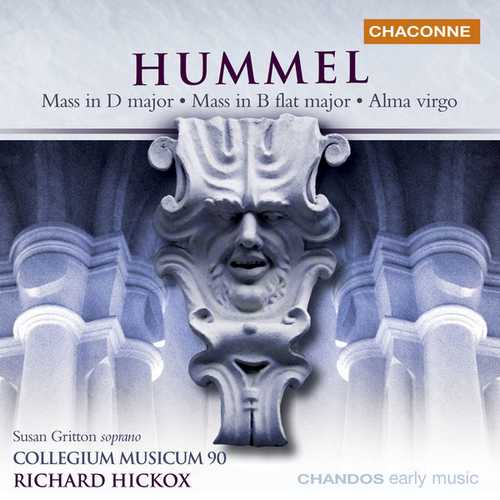

Composer: Johann Nepomuk Hummel
Performer: Susan Gritton
Orchestra: Collegium Musicum 90
Conductor: Richard Hickox
Format: FLAC (tracks)
Label: Chandos
Catalogue: CHAN0681
Release: 2002
Size: 760 MB
Recovery: +3%
Scan: cover
Mass in D major Op. 111
01. Kyrie
02. Gloria: Gloria in excelsis Deo
03. Gloria: Qui tollis peccata mundi
04. Gloria: Quoniam tu solus sanctus
05. Gloria: Cum Sancto Spiritu
06. Credo: Credo in unum Deum
07. Credo: Et incarnatus est
08. Credo: Et resurrexit
09. Credo: Et vitam venturi
10. Sanctus
11. Benedictus
12. Agnus Dei
13. Alma virgo mater, WoO 21, S66
Mass in B flat major Op. 77
14. Kyrie
15. Gloria: Gloria in excelsis Deo
16. Gloria: Qui tollis peccata mundi
17. Gloria: Quoniam tu solus sanctus
18. Credo
19. Sanctus
20. Benedictus
21. Agnus Dei
When the glories of Haydn’s late Masses have been widely appreciated, it’s sad that Hummel’s have been so neglected.
They are for chorus and orchestra alone, without soloists, which may have deterred potential performers.
However, while they can’t quite match late Haydn or Beethoven in originality, they’re lively, beautifully written, and full of striking ideas, inspiring Hickox and his team to performances here just as electrifying as those they have given of Haydn, and just as vividly recorded.
Hummel follows Haydn in both Masses in his fondness for fugues. Similarly, he follows Haydn in offering joyfully energetic settings of ‘Dona nobis pacem’, only unlike Haydn he doesn’t end either Mass on a fortissimo cadence, instead fading down the final phrases, maybe for liturgical reasons in the context of a church performance. Hummel, like Haydn and Beethoven before him, fully brings out the drama of the liturgy, though in both settings of ‘Et resurrexit’ he begins not with a sudden fortissimo but with a rising crescendo, as though a crowd of bystanders are gradually appreciating the wonder of it.
Another symbolic point is that the Mass in B flat, dating from 1810, the year before Hummel left the Esterházy court, includes a setting of the Credo with distinctive unison and octave passages for the chorus, as though to emphasise unity of belief. In both masses the settings of the Sanctus are surprisingly brief, even perfunctory, yet the musical ideas could not be more striking, with a gently flowing 6/8 setting in the D major work and a bold setting in the B flat Mass which crams into the shortest span surprisingly varied ideas.
Thanks to the imagination of Richard Hickox, we’re finally able to discover the joys of Hummel’s Masses. An extremely fine disc.